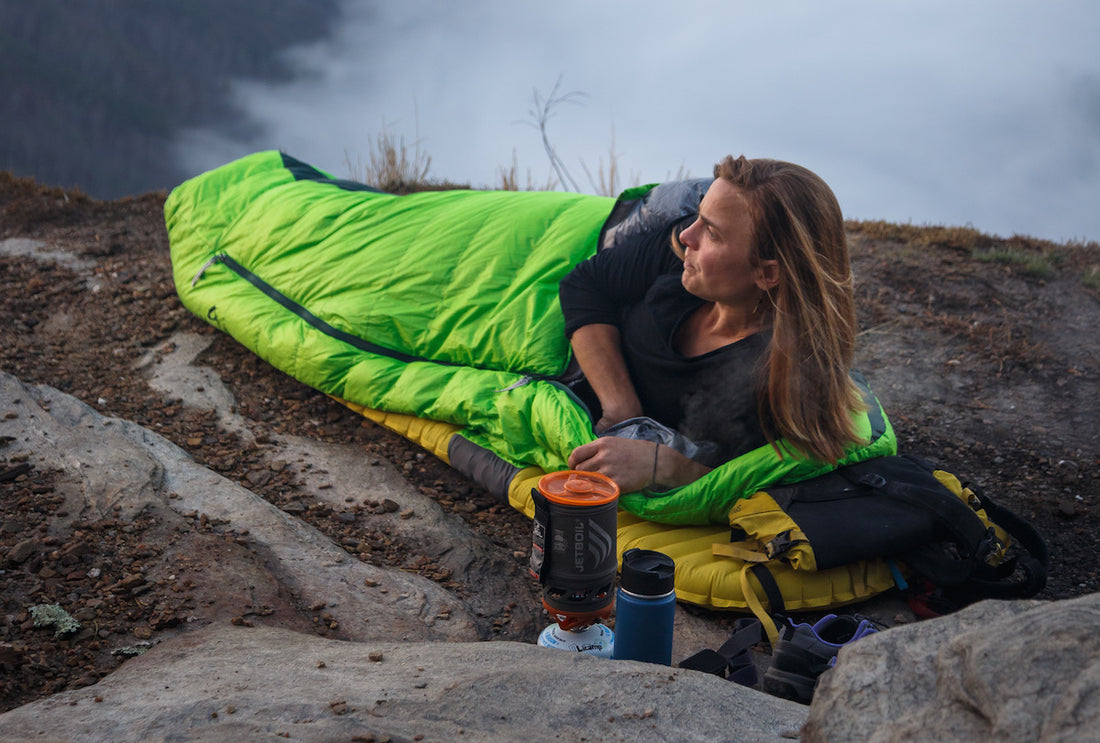
Shoulder Season Questing with the Questar
Jenny Abegg
It’s finally time. A harsh and wet winter has left you with cabin fever. After constantly checking the weather, you finally see the perfect window for your next adventure.
In this edition of Therm-a-Rest Gearshed, contributor Jenny Abegg takes the Questar sleeping bag out for some shoulder season adventures.
When I think of a three-season sleeping bag, images of t-shirts at the crag and fires in the evening come to mind, of hut trips one weekend and surf trips the next, of vibrant colors, warm days, morning frost, and night chill. These are images of shoulder season: the months of transition between the extremes of winter and summer, of dark and light.
Fall and spring are arguably the best time to quest outside and enjoy an evening in the wilderness. Climbing temperatures are perfect. Crowds are at their minimum. The outdoors are at their most colorful. Days are warm, but the nights are chilly—not any old sleeping bag will do. Temperatures can easily drop below freezing, and your ultralight summer bag won’t quite cut it. However, a winter bag is both overkill on warmth and bulk this time of year.
The solution? A three-season sleeping bag. And Therm-a-Rest’s solution to the three-season sleeping bag? The Questar. The Questar is Therm-A-Rest’s newest comfort-meets-quality brainchild. The bag is constructed with the same high-performance materials and design as their elite bags, but is roomier, and sports comfort features like an ergonomic footbox and over-sized draft tube.
This March, the Questar was my shoulder season sleeping bag of choice. I took it along with me on my journeys, from the steep sandstone crags of Tennessee and North Carolina’s “Grand Canyon of the East,” to the granite boulderfields of Bishop, California and coastal porches of British Columbia. Here’s a peek into our travels:
In Tennessee, the Obed boasted mild nights and rainy days, and yet we were still able to climb on the insanely steep roofs for which the area is known. We camped at the Lilly Pad, an amazing climber’s campground run by a pair of locals. Despite the carefully designed and constructed community buildings, fire ring, and hillbilly hot tub, we struggled to find a flat spot to bed down. Luckily, the Synergy Link straps on the Questar not only keep the bag righted on my mattress, but they also prohibit the bag from sliding off my sleeping pad. With a backpack at my feet and the Synergy Link straps, I slept deeply, dreaming of climbing upside down on endless, juggy roofs.
It was unseasonably warm in North Carolina’s Linville Gorge, locally known as the “Grand Canyon of the East.” By day we climbed on wind-less, south-facing walls and at night bedded down on a beautiful rock outcropping on the rim, opting for the more exposed camping-with-a-view instead of in one of the area's many secret caves. My sleeping bag was riddled with dew in the morning, but the outer material beaded the water, leaving me dry and snug inside. I was certainly calmed to know that the Questar was made of hydrophobic down and that it could handle the dew while keeping me warm...especially when I then spilled my tea all over my bag.
In Bishop for the Women’s Climbing Festival, I camped out near the hot springs, treating myself to a dip each morning to start the day. My sleeping bag, however, was so warm and cozy that I barely wanted to trade it for steaming water with a Sierra view. It wasn’t until this trip to the desert that I really encountered some cold shoulder season nights, and was absolutely amazed to discover the Toe-asis™ foot box in the Questar one evening as I burrowed my feet to get warm. The optional built-in mono slipper sure keeps things toasty - an oasis for my toes indeed.
From the deck of the family’s cabin on Saturna Island in British Columbia, my friend Alissa shouts, “Is that one!?!” before soberly realizing, “Oh, never mind, it’s just a wave.” She may have failed to spot the elusive pod of migrating Orca whales, but at least she was warm, wrapped in the soft down of the Questar. By night, some of us chose ocean breezes and the sound of waves lapping on the shore over warm beds inside. I zipped the Questar tight, cinching the draft tube around my neck to keep out the whipping sea air. My sleep was deep, the bag like a safe, roomy hug, and the dew that descended upon us in the morning was again no match for the Questar.
I breathed deeply: from the Southeast to California’s Eastern Sierra, all the way now to the coast of British Columbia, this spring was a busy one, full of adventure, movement, change, and friends old and new. Through it all, as spring began to sprout from our deep, wet winter, the Questar was the perfect companion for my shoulder season adventures.









